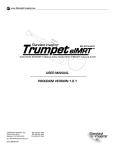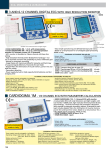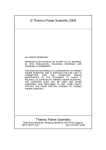Download Medium Energy Linear Accelerator BID SPECIFICATION
Transcript
Medium Energy LINAC Bid Specifications February 28, 1995 Medium Energy Linear Accelerator BID SPECIFICATION 1.0 GENERAL REQUIREMENTS 1.1 INTRODUCTION e l p m a S This specification defines the performance, reliability, and features of a Medical Linear Accelerator system. Bidders answering this specification shall meet the following general and specific requirements to be considered for award for any contract that results from this bid. 1.2 FULL PRODUCTION SYSTEM The units shall be in production. The definition of production means: • The unit or option shall be defined by a set of production drawings. It must have been tested with clinical results which shall be included in the bidder's proposal. These results shall represent material for the buyers evaluation. It is the bidder's responsibility to furnish sufficient data to validate that the items are in production, if so requested by the buyer. The bidder shall be able to show detailed design information, facilities and other supporting data relating to bid items. This should include items such as service manuals, installation data and dimensional data. The bidder must supply FDA exemptions for all components that have not received final FDA approval. 1.3 RELIABILITY • 1.4 Successful bidder shall provide guarantee and provisions for at least ninety-six per cent uptime. SUPPORT 1.4.1 Installation instructions and service The successful bidder shall provide pre-installation data and price quotations for room preparation and service power requirements. The bidder shall provide a quotation for removing the existing linear accelerator. An installation team shall be provided by the vendor to install the new accelerator. Community Hospital will be responsible for ALL room preparation to accept the vendor’s equipment. The vendor will be required to make submittals and be present for any architectural modifications to accept the actual components of their awarded equipment (i.e. baseplates and false walls) 1.4.2 System checkout 1 Medium Energy LINAC Bid Specifications February 28, 1995 An acceptance test procedure shall be conducted upon completion of the installation and testing of the accelerator. The terms and conditions of this procedure shall be in writing and shall be satisfied by both parties prior to the acceptance of the equipment by Community Hospital. 1.4.3 Operator and applications training 1.4.3.1 The vendor shall provide at least four days of applications training at the treatment facility prior to clinical operation of the accelerator. This training shall be provided to all staff identified by Community Hospital. e l p m a S 1.4.3.2 The vendor shall supply at least three days physics training prior to, and separate from, the acceptance testing. 1.4.4 Service Training The vendor shall provide at least two weeks service training to one individual identified by Community Hospital. This training shall occur at the vendor’s manufactoring/service facility. All associated travel and reasonable living expenses will be paid by the vendor. 1.4.5 Operator and service manuals A complete set of manuals and circuit diagrams shall be provided with the accelerator. The manuals shall include, but not be limited to; Operators Manual, Physicist Manual and Service Manual. All documentation shall be provided in English. 1.4.6 Integrated software package The accelerator shall be delivered with latest version of software available at the time of shipping. All future software release which address safety, or reliability of the accelerator shall be provided to the Community Hospital free of charge. Software releases which increase the functionality or capabilities of the accelerator shall be made available at an aggressive price. 1.4.7 Warranty service There shall be a warranty period of one year which begins upon the completion of equipment installation and acceptance. During this period, service shall be provide by a trained service engineer who resides in Gotham City. The vendor shall also provide a trained back-up engineer in the area during the warranty period. Bidder shall guarantee that a service engineer will arrive on-site within one hour from placement of the service call by Community Hospital. 1.4.8 Out of warranty service 2 Medium Energy LINAC Bid Specifications February 28, 1995 Bidder shall provide copies of post warranty service contracts that are available. Contracts should include quotations that include a trained service engineer who will reside in Gotham City, with local backup, for the term of the contract. All proposals should contain a cancellation clause executable by Community Hospital. These contracts shall provide a firm quote for service under each of the following conditions: 1. Full parts and labor for a 7 year term post warranty period (PWP) 2. Full parts only for a full 7 year term (PWP) 3. Partial service and parts beyond a cap for a full 7 year term (PWP) e l p m a S 4. Parts only beyond a cap for a full 7 year term (PWP) 2.0 SYSTEM COMPONENTS AND OPERATIONAL CAPABILITIES 2.1 TECHNICAL DESCRIPTIONS 2.1.1. Accelerator Guide The accelerator guide shall be a standing wave single section guide capable of operating with a variable frequency without phase shifting to achieve an acceleration process which can produce a variable spectrum of energies. 2.1.2 Electron Gun The electron gun shall be a demountable gun which is capable of ejecting a focused beam into the accelerator guide and being replaced in the field without replacing the waveguide. 2.1.3 Ion Chamber The ion chamber shall consist of two separate, and independent ion chambers. Each of these independent chambers hall be capable of monitoring the beam performance for flatness and symmetry, as well as dose delivery. The ion chambers can be open and if so, the accelerator shall be capable of dynamic corrections for temperature and pressure. 2.1.4 Bending Magnet The bending magnet shall be a single pole bending unit which manipulates the beam through an angle of 270 degrees. The unit shall contain an energy defining aperture such that the electron energy spread shall be less than or equal to 5%. 2.1.5 Target Assembly 3 Medium Energy LINAC Bid Specifications February 28, 1995 The target assembly shall be contained in the head of the accelerator assembly at the output of the beam. It shall be housed inside or outside of the vacuum section of the guide, and shall provide the targets for photon beams, as well as the primary scattering foils for electron beams. 2.1.6 RF Source The accelerator shall have a magnetron as its source of RF power. 2.1.7 Distances e l p m a S The accelerator shall have an isocenter distance of 100cm from the source. 2.1.8 Light Source The light source for the field light shall be housed in the collimator head of the accelerator in such a manner as to project a beam of light toward the treatment field. The light source should project the radiation field without the aid of a reflection mirror. 2.1.9 Spare Parts A spare parts kit shall be provided on site with each accelerator. 2.1.9.1 Replacement parts shall be available from local parts depots in the United States. 2.2 PHOTONS • The Linear Accelerator should offer one photon energy, upgradable to at least two photon energies. Effective energies shall be defined by BJR 17. 2.2.1 Effective Energies A combination of energies should be available from at least the following: 4, 6, 8, 10, 12 and 15 MV. 2.2.1.1 The selected Photon energy shall have an independent flattening filter specific to that energy. 2.2.1.2 There shall be an electromechanically interlocked method of changing the flattening filters. 2.2.1.3 There shall be a target for specifically designed for low energy photons. The focal spot size shall be less than or equal to 2mm 2.2.1.4 Dmax as defined in the specifications of BJR 17 2.2.1.5 Percentage Depth Dose at 10cm as defined in the specifications of 4 Medium Energy LINAC Bid Specifications February 28, 1995 BJR 17 2.2.1.6 2.2.2 Surface dose shall be defined by a measurement taken at a depth of .05cm in water with a semiconductor probe. The water surface shall be at 100cm and a field size of 10cm x 10cm. Dose Rates Dose rate shall be selectable with at least 2 dose rates available at each photon or electron energy upon request. e l p m a S 2.2.2.1 The time averaged dose rate should be consistent to within +/- 3% 2.2.3 Field Size The beam limiting system shall offer continuously variable unclipped field sizes from 2cm x 2cm to 40cm x 40cm at 100cm SSD, and shall have square corners on symmetrical fields contained within a 56cm diameter circle measured at isocenter. 2.2.3.1 The field size shall be accurate to within +/- 2mm or 1% when measuring the xray field against the light field. 2.2.3.2 There should be to dual asymmetric collimators; each of which shall be capable of independent movements from 20cm from central axis to 10 cm beyond central axis for a total travel of 30cm for any single jaw. The dual asymmetric collimator shall maintain capability of a 40cm x 40cm unclipped field size at isocenter. 2.2.4 Flatness Flatness for field sizes of 10cm x 10cm up to and including 30cm x 30cm shall not vary by more than +/- 3% on either side of center over 80% of the length of the median lines, and over 60% of the diagonals. For field sizes greater than 30cm x 30cm the variation shall not be greater than +/- 5%. 2.2.5 Symmetry Symmetry for field sizes greater than 10cm x 10cm shall not vary by more than +/- 2% of the arithmetic mean when measured at two points equidistant from center across 80% of the median lines, and 60% of the diagonals. 2.2.6 Penumbra For a square field of 10cm x 10cm at a distance of 100cm from the target, at a depth of 10 cm in water, the penumbra shall be less than or equal to 6mm for energies greater than 10 MV and less than 7mm for 4, and 6MV. Penumbra shall be defined as the distance between measured on the median lines between the 80% and 20% isodoses. 5 Medium Energy LINAC Bid Specifications February 28, 1995 2.2.7 Radiation Leakage All radiation leakage shall conform to the recommendations drawn out in I.E.C documentation. 2.2.7.1 Radiation leakage through the beam limiting system shall be less than 0.5% 2.2.7.2 Radiation leakage on the patient plane shall be less than 0.1% on the average, and less than 0.2% maximum. 2.2.7.3 Radiation leakage outside of the patient plane shall be less than 0.1% e l p m a S 2.2.7.4 Neutron leakage shall be less than or equal to 27mGy / Gy 2.2.7.5 Refer to section 2.2.9 for Multileaf collimator leakage specifications. 2.2.8 Automatic, Dynamic and Standard Wedge Filters An automatic or dynamic wedge filter shall be installed internal to the collimator head in conjunction with the beam limiting system. 2.2.8.1 When centered on the collimator axis, the automatic wedge shall cover a maximum field size of 20cm in the X axis, and 40cm in the Y axis. 2.2.8.2 The automatic or dynamic wedge shall be capable of emulating effective wedge angles variable between zero and 60 degrees. 2.2.8.3 The automatic or dynamic wedge filter shall be positioned such that wedge fields may be prescribed in the plane with the leaves on and MLC without the use of external wedges. 2.2.8.4 A standard set 150, 300, 450 and 600 wedge filters shall be supplied. 2.2.9 Multileaf Collimator (MLC) There should be an option of, or upgrade path to, Multi-Leaf Collimation. The MLC should be fully integrated into the head of the machine such that the source distance of the collimators is consistent with the standard collimator head. 2.2.9.1 Field size limitations of the MLC should be consistent with the maximum field size available on the linear accelerator (unclipped). This should be 40 cm2. 2.2.9.2 Individual leaf width (at isocenter) should be ≤ 1.25 cm. 2.2.9.3 There should be double leaf focusing. 2.2.9.4 Biplanar overaxis leaf travel should be possible and capable of full asymmetry in at least one plane. This allows MLC usage for half beam blocking. 6 Medium Energy LINAC Bid Specifications February 28, 1995 2.2.9.5 MLC movement should be linear and allow for simultaneous movement. There should be one drive motor for each jaw and leaves. 2.2.9.6 There should be two pairs of primary x-ray jaws. 2.2.9.7 Movement accuracy should be ± 1 mm. 2.2.9.8 The addition of MLC to the linear accelerator should not alter the collimator surface to isocenter distance. 2.2.9.9 MLC should be compatible with treatment accessories including rotated and standard wedge filters, compensators and traditional shielding blocks (for back-up in the event that MLC requires service). e l p m a S 2.2.9.10 In electron mode, the MLC should act as the primary collimator and automatically adjust dimensions to coincide with the electron applicator. 2.2.9.11 Dosimetric Characteristics These characteristics address the beam leakage and collimation for photon and electron beams. The smallest possible values are desirable. The required characteristics and specifications are: 2.2.9.11.1 Leaf leakage should be < 1% (average). 2.2.9.11.2 Interleaf leakage should be < 1%. 2.2.9.11.3 Leakage at the leaf ends should be < 1%. 2.2.9.11.4 Leakage in the patient plane (outside the maximum field) should be < 0.1% (average). 2.2.9.11.5 Leakage out of the patient plane, at one meter should be < 0.2%. 2.2.9.11.6 Penumbra should be ≤ 3 mm beyond penumbra of the rectangular field. 2.2.9.12 Control Specifications The control features allow software control at the control console, treatment planning area and treatment unit. MLC control should be part of an integrated computerized planning and delivery system. The MLC computer control should allow electronic transmission of leaf positions from treatment planning/virtual simulator workstations. The specific control features, characteristics and specifications are as follows: 2.2.9.12.1 There should be a graphical display of prescribed MLC position, actual settings and positional discrepancies at the linear accelerator control console. 7 Medium Energy LINAC Bid Specifications February 28, 1995 2.2.9.12.2 The MLC should be networked to accept direct input from a film digitizer and treatment planning/virtual simulator workstations. 2.2.9.12.3 Computer control should store MLC positions and provide automated set-up of MLC positions. 2.2.9.12.4 There should be manual editing capability. 2.2.9.12.5 Software controls should allow for dynamic movement during treatment for conformal treatments. 2.3 ELECTRONS e l p m a S The Linear Accelerator shall offer a selection of up to eight electron energies for clinical treatment. Effective energies shall be defined by their 80%, 50% and 20% points relative to maximum. 2.3.1 Effective Energies A combination of energies shall be available from 4 MeV to at least 15 MeV . 2.3.2 2.3.3 2.3.1.1 Each electron energy shall utilize a dual scattering foil process to optimize flatness. 2.3.1.2 There shall be a separate secondary foil specific to each electron energy 2.3.1.3 There shall be an electromechanically interlocked method for changing scattering foils. 2.3.1.4 Xray contamination shall be less than 5% maximum for highest electron energy when measured at 10cm beyond the practical range as defined by I.E.C. standards. Dose Rates 2.3.2.1 Dose rate shall be selectable for all energies. The minimum available dose rate should be 200 monitor units per minute. 2.3.2.2 An optional dose rate of 1000 monitor units per minute shall be available 2.3.2.3 Time averaged dose rate should be consistent to within +/- 3% Field Size The field size shall be continuously variable from 2cm x 2cm to 30cm x 30cm. Each electron collimator shall be capable of mounting cutouts, or lead strips to define irregular fields. 2.3.4 Flatness Flatness for field sizes of 10cm x 10cm and greater shall not vary by more than +/- 3% on 8 Medium Energy LINAC Bid Specifications February 28, 1995 either side of center over 80% of the length of the median lines, and over 60% of the diagonals for energies greater than 6MeV. For energies of 6MeV and less the variation shall not be greater than +/- 5%. 2.3.5 Symmetry Symmetry for field sizes greater than 10cm x 10cm shall not vary by more than +/- 2% of the arithmetic mean when measured at two points equidistant from center across 80% of the median lines, and 60% of the diagonals. 2.4 ARC THERAPY 2.4.1 e l p m a S Specifications 2.4.1.1 The accelerator shall be capable of arc therapy in all photon and electron energies. 2.4.1.2 The system should be capable of performing arcs in either the clockwise or counter clockwise directions. 2.4.2 Dose Rates Dose rate shall be variable between .33 monitor units per degree, and 10 monitor units per degree. 2.4.2.1 2.5 The dose rate accuracy shall be less than 3% or 1 monitor unit, whichever is greater. MECHANICAL SPECIFICATIONS 2.5.1 Gantry The gantry shall be capable of rotating in either direction through a total of 370 degrees. 2.5.1.1 Gantry readouts should be in degrees, and shall be accurate to within +/- 1 degree 2.5.1.2 A mechanical readout shall be available on the gantry, and digital readouts shall be available both in the room, and at the console. 2.5.1.3 The accelerator shall have mechanical stops for the gantry rotation in the clockwise direction, and in the counter-clockwise direction. 2.5.1.4 Though a 360 degree arc, the rotational runout of the gantry shall be confined 1mm radius measured at isocenter. 2.5.1.5 The source to isocenter variance shall be less than or equal to 2mm through a 360 degree arc. 9 Medium Energy LINAC Bid Specifications February 28, 1995 2.5.1.6 The gantry should be cable of variable motorized movement between 40 and 300 degrees per minute. 2.5.1.7 There shall be an optical distance indicator housed in the gantry which projects a light scale calibrated in centimeters from approximately 80 cm to 140cm. The precision of this indicator shall be accurate to within +/- 2mm. 2.5.2 Collimator e l p m a S The collimator shall be capable of rotation in either direction through a total of 370 degrees. 2.5.2.1 Collimator readouts should be in degrees, and shall be accurate to within +/- 1 degree. 2.5.2.2 A mechanical readout shall be available at the collimator, and digital readouts shall be available both in the room, and at the console. 2.5.2.3 The collimator shall have mechanical stops for the rotation at in the clockwise direction, and in the counter-clockwise direction. 2.5.2.4 Though a 360 degree rotation, the runout of the collimator shall be confined to a 1mm radius measured at isocenter. 2.5.2.5 There shall be a set of crosshairs mounted to the collimator section which define the center of the field. These crosshairs shall be accurate to center within +/- 1mm, and shall have a rotational runout coincident with the collimator which is confined to a radius of 2mm. 2.5.3 Treatment Couch The treatment couch shall be capable of supporting a patient weighing up to 400 lbs and shall provide operational characteristics to support isocentric treatments. 2.5.3.1 The maximum sag of the treatment couch shall be less than or equal to 5mm. 2.5.3.2 There shall be a mylar or "tennis racket" treatment window to allow for opposing field treatments. The maximum deflection of this mylar window shall be less than or equal to 5mm. 2.5.3.3 The treatment couch shall have a movable centerspine inherent to its design to facilitate oblique or tangential treatments without movement of the patient. 2.5.3.4 The couch shall have motorized vertical movement range from the 10 Medium Energy LINAC Bid Specifications February 28, 1995 floor allowing for large effective maximum field sizes in the AP direction and the PA direction. 2.5.3.5 The treatment couch shall be capable of rotating +/- 120 in either direction around isocenter. 2.5.3.6 The table top shall have motorized movement through a 370 degree rotation. It shall have motorized movement in the lateral plane of +/- 20cm from center, and shall have motorized movement in the longitudinal plane of 60cm. 2.5.3.7 The table top should possess a free floating capability in the lateral and longitudinal planes. e l p m a S 2.5.3.8 Readouts for the treatment couch should be in millimeters, or degrees and shall be accurate to within +/- 1mm or 1 degree. 2.5.3.9 Mechanical readouts shall be available at the treatment couch, and digital readouts shall be available both inside the treatment room, and at the treatment console. 3.0 3.1 EASE OF USE PERFORMANCE REQUIREMENTS COUCH AND GANTRY 3.1.1 Hand Control Pendant The hand control pendant shall be easily accessible from all locations around the treatment couch. 3.1.1.1 The hand control pendant shall be capable of entering parameters digitally, as well as controlling movements manually. 3.1.1.2 The hand control pendant shall offer simultaneous movement of gantry, collimator, and jaw functions. 3.1.1.3 An automatic set up feature shall be available on the hand control pendant as well as the operators console. 3.1.1.4 The field light and optical distance indicator shall be controlled from the hand control pendant as well as the operators console. 3.1.2 In Room Monitor An in room console monitor shall be provided as standard with the accelerator. 3.1.3 Accessories There shall be an accessory holder that is mountable to the collimator head of the accelerator. 11 Medium Energy LINAC Bid Specifications February 28, 1995 3.1.3.1 The accessory holder shall have the ability to hold compensators and blocks at the same time. 3.1.3.2 Coding shall be available for all accessories. 3.1.3.3 The optical distance indicator shall be continuously readable when accessories are in place. 3.1.3.4 The weight of any single accessory attachment to the machine should not be more than approximately 20 pounds. 3.1.3.5 All accessories shall be compatible with any collimation system. Multi-leaf collimators shall not require additional or separate accessories. e l p m a S 3.1.3.6 The vendor should supply a radio-opaque graticule tray that projects a 1 cm grid pattern at isocenter. 3.1.3.7 The vendor shall supply a set of standard blocking trays. 3.1.3.8 The vendor shall supply an electron cutout kit for use with low melting point shielding alloys. 3.2 OPERATOR CONSOLE 3.2.1 Operator Console, Medical Mode The operator console shall have available a medical mode which is designed for patient irradiation. 3.2.1.1 The console shall consist of one keyboard, one CRT, and one hard copy printing device. 3.2.1.2 Manual entry of prescriptions should be simple, menu driven through use keyboard and/or a mouse. 3.2.1.3 Automatic set-up feature shall be available from the console. 3.2.1.4 The console should provide a simple means of distinguishing discrepancies between prescribed and actual parameters. 3.2.1.5 In case of power failure, a means of preserving the total dose delivered to the patient under treatment shall be provided. This counter shall maintain the reading until power is restored and a new treatment is started. 3.2.1.6 All information shall appear in English on the screen. 3.2.1.7 The medical mode shall consist of a separately configured port film mode that can be accessed from the treatment prescription. 12 Medium Energy LINAC Bid Specifications February 28, 1995 3.2.1.8 The controls for beam on /off shall be separate hardware control switches or buttons. 3.2.1.9 A deadman switch shall be provided at the console which must be used when operating motions from the console area. This deadman shall be a required component when performing arc therapy. 3.2.1.10 The multi-leaf collimator shall be fully integrated electro-mechanically to the linear accelerator and the control console. All motions shall be controlled from and monitored by a common platform console. 3.2.2 Operator Console, Physics Mode e l p m a S The operator console shall have available a physics mode which provides for the performance of utility functions, non-patient irradiation, and adjustment. 3.2.2.1 There shall be a graduated password system to control access to different functions. 3.2.2.2 The physics mode shall offer the capability to customize the machine operation in the medical mode to specific hospital protocols. 3.2.2.3 Configuration of default parameters shall be accomplished in this mode. 3.2.2.4 The physics mode shall be capable of irradiation testing without having to manually override patient safety interlocks. These interlocks shall be reactivated during transition back to the medical mode. 3.2.2.5 The physicist should have static and dynamic parameters available for viewing as a troubleshooting aid. 3.2.2.6 All information shall appear in English on the screen. 3.2.2.7 There shall be a function to store dose monitor unit calibration factors. 3.2.2.8 The physics mode shall provide the ability to lock out certain machine functions and prevent their use in the medical mode. 3.2.3 Operator Console, Maintenance Mode There shall be available a maintenance mode which provides for the performance of service and adjustments. 3.2.3.1 All geometric and physical parameters shall be digitally adjusted before and during irradiation in this mode. 13 Medium Energy LINAC Bid Specifications February 28, 1995 3.2.3.2 The maintenance mode shall offer the availability for all parameters to be displayed, printed, and stored on floppy disk. 3.2.3.3 This mode shall provide the ability to monitor accelerator operation by digital display of all static and dynamic parameters. 3.2.3.4 The Linear Accelerator shall offer the option of or upgrade path to remote diagnostic capabilities. This remote diagnostics system shall be fully integrated to the accelerator console and shall not require an additional control console for operation. The remote station shall be monitored and operated by fully qualified support engineer. e l p m a S 4.0 SAFETY AND SYSTEM INTERLOCKS 4.1 SAFETY INTERLOCKS The accelerator shall be equipped with a minimum of, but not be limited to, the following interlocks designed to prevent or terminate treatment in the case of malfunction. Only when all interlocks are in the proper mode shall the accelerator be operable. 4.1.1 Primary Dose Shall provide a means of terminating the beam when the primary dose counter has matched the preselected number of monitor units in the prescription. 4.1.2 Secondary Dose In the event of primary dose failure, the beam shall be terminated if the dose counted by the secondary channel reached some constant percentage greater than the preselected number of monitor units in the prescription. 4.1.3 Flatness There shall be a means of terminating the beam if an excessive deviation in beam flatness occurs in either monitoring chamber. 4.1.4 Symmetry There shall be a means of terminating the beam if an excessive deviation in beam symmetry occurs in either monitoring chamber. 4.1.5 Excess Dose Rate There shall be an interlock to terminate the beam if the dose in the primary chamber exceeds the selected dose rate by more than 25%. 4.1.6 Under Dose Rate There shall be an interlock to terminate the beam if the dose rate monitored by the primary chamber drops below 50% of the selected dose rate. 4.1.7 Dose Rate tracking between dosimetry channels 1 and 2 There shall be an interlock to terminate the beam in the event of a discrepancy greater than 2.5% between the two monitoring chambers. 4.1.8 Treatment Elapsed Time 14 Medium Energy LINAC Bid Specifications February 28, 1995 In the event of a failure of both dose monitors, there shall be an alternate means of terminating the beam if the time counter matches the preselected time in the prescription. 4.1.9 Mode Select There shall be a group of interlocks to prevent the beam from being activated in the event of any error in positioning of foils, flattening filters, target, or any other components associated with the energy selected at the console. 4.1.10 Bending Magnet Current There shall be a means of terminating or inhibiting the beam if the nominal value of the current of the bending magnet varies by greater than 300mV. e l p m a S 4.1.11 Wedge Filter vs Field Size There shall be a mean of inhibiting the beam if the selected field size exceeds the dimensions of the wedge filter during a treatment involving the use of a wedge. 4.1.12 Improper Code 4.2 There shall be a means of inhibiting the beam in the event of any mismatch between an accessory, and it's associated code. SYSTEM INTERLOCKS The accelerator shall be equipped with a minimum of, but not limited to the following interlocks designed to protect the machine against damage and to assure that the intended machine settings are correct and critical operating parameters are within limits. 4.2.1 Cooling Water Level There shall be a means of terminating or inhibiting the beam in the event of low level cooling water. 4.2.2 Cooling Water Temperature There shall be a means of terminating or inhibiting the beam if the cooling water temperature rises above nominal. 4.2.3 Wave Guide Vacuum There shall be a means of terminating or inhibiting the beam if the vacuum level in the accelerator guide exceeds preset limits. 4.2.4 Gantry Limits There shall be a means of terminating or inhibiting the beam if the gantry is displaced outside of secure tolerance during irradiation. 4.2.5 SF6 Pressure There shall be a means of terminating or inhibiting the beam if the pressure of the dielectric gas in the wave guide drops below preset limits. 4.2.6 Warm up Time Delay There shall be a time delay interlock to inhibit machine operation during modulator warm-up. 15 Medium Energy LINAC Bid Specifications 4.2.7 4.3 Cabinet Doors February 28, 1995 There shall be a means of interrupting of inhibiting the beam if the cabinet doors are not closed securely during treatment. FACILITY INTERLOCKS Connections shall be provided for the following interlock functions which will prevent or terminate radiation. 5.0 4.3.1 Treatment Room Door There shall be an interlock to terminate or inhibit treatment if the door to the treatment room is not closed securely. 4.3.2 Emergency Off e l p m a S The machine shall have the capability of connection to emergency off switches which may be installed throughout the treatment room and console area. ACCESSORIES 5.1 LASER LOCATOR LIGHTS A gantry mounted back pointer laser shall be supplied. 5.2 TREATMENT COUCH ACCESSORIES The vendor shall supply patient arm and leg supports, along with a film holding device for AP, PA and Lateral port films. 5.3 ELECTRONIC PORTAL IMAGING DEVICE The Linear Accelerator shall have a mounted real time portal imaging device. 5.3.1 The Electronic Portal Imaging Device (EPID) shall offer a selection of modes for the acquisition of images. It shall be capable of image acquisition in either a single or double port film mode as well as capturing a series of images during a treatment mode. 5.3.2 The acquisition time and frequency of images shall be variable. The system shall be capable of acquiring an image within one second with a minimal amount of dose. 5.3.3 The EPID shall utilize a phosphorous screen which provides maximum sensitivity without compromise to spatial resolution. It shall incorporate a videocamera system for imaging and have a minimal spatial resolution of a 512 x 512 x 8 bits. 5.3.4 The EPID have a networking capability such that reference images my be received from a simulation station in conjunction with treatment planning. It shall additionally be capable of receiving CT scans or digitally reconstructed radiographs as reference images. 5.3.5 The EPID shall include a laser film digitizer such that films taken on a conventional simulator may be used as reference images. 5.3.6 The EPID workstations RISC based for speed and graphical imaging processing. 16 Medium Energy LINAC Bid Specifications February 28, 1995 5.3.7 The EPID system should be compatible with the Community Hospital, Department of Radiation Oncology’s existing ethernet network and Dicom 3 network protocol. 5.3.8 The EPID should be video camera-based for portal imaging that confirms dynamic conformal fixed and rotational treatments. 5.3.9 The EPID should be retractable with motorized movement for ease of use. The detector shall have a range of travel such that it may be fully retracted when not in use, and shall offer a range of vertical movements to maximize sensitivity and magnification. 5.3.10 Anti-collision device should interface with the linear accelerator. 5.3.11 The software should be capable of image enhancement including spatial enhancement, window/level and inversion, image magnification, image subtraction and addition, image rotation and flip, and histogram equalization and edge enhancement. e l p m a S 5.3.12 Image management should include automatic and user selectable storage of images onto the hard disk, on line review, registration of patient information on the images and image annotation, and ability to acquire image sequences for post treatment viewing of movie loop. 5.3.13 Image comparison should include automatic retrieval of reference image (DRRs, simulator film). These should be transferred via computer network. 5.3.14 Online side by side comparison of acquired image with reference image and alignment and superposition should also be included. 5.3.15 The vendor should supply a color printer for EPID image hardcopy. 17



























